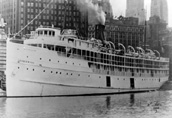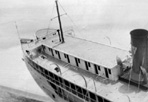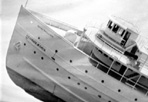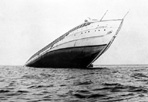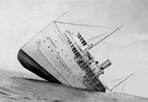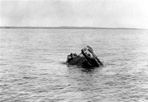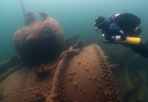Panoramic001.jpg)
SS George M. Cox
Quick Facts
USS Puritan
1901
Craig Shipbuilding Company
259 feet
1,762 tons
Graham & Morton Line (Goodrich Transit Co.)
Isle Royale Transit Co.
George E. Johnson
127 Passengers and Crew
Isle Royale Transit Co.
Insured
U.S. 150898
5/27/1933
$200,000
Near Rock of Ages Lighthouse
Minimum 10 feet; maximum 100 feet
0
84001749
T
he steel passenger screw-steamer GEORGE M. COX was named PURITAN by the Craig Shipbuilding Co. of Toledo, Ohio in 1901. U.S. Registry No. 150898 (June 7, 1901) listed the owner of the vessel as the Craig Shipbuilding Co., and gave the dimensions: 233 feet long, 40.5 feet wide and 21.9 feet deep. The ship had no masts, two decks, a plain head and round stern. The tonnage capacity under deck was 1169.08; the capacity between decks above the tonnage deck was 378.53 tons, yielding a gross tonnage of 1547.61. A deduction of 495.04 tons was allowed, giving a net tonnage of 1052.
The ship was designed for the overnight passenger service. The first owners, the Holland and Chicago Transportation Co., intended to name the vessel OTTAWA. Before hull 82 was completed, the Holland and Chicago Co. was bought by the Graham and Morton Transportation Co. The new owners named the vessel PURITAN and launched the ship on the afternoon of May 1, 1901 ( Detroit Eree Press May 2, 1901).
The Craig Shipbuilding Co. owned PURITAN from June 7 to June 28, 1901. Graham and Morton Transportation Co. retained ownership until December 27, 1902, when ownership was transferred to J. H. Graham of St. Joseph, Michigan.
Operational History
USS Puritan: World War I
PURITAN was one of several Great Lakes ships summoned to serve in World War I. There were at least five of the Lake Michigan passenger-steamer fleet called to U.S. Naval service: THEODORE ROOSEVELT, CITY OF SOUTH HAVEN, VIRGINIA, MANITOU and PURITAN ( Fort William Daily Times Journal April 9, 1918). PURITAN was purchased by the U.S. Navy in April, 1918 and commissioned November 20 of the same year (U.S. Department of the Navy 1970:5:405; Lake Carriers' Association Annual Report 1918:149). The ship's enrollment papers were surrendered October 23, 1918 (Consolidated Certificate of Enrollment and License PURITAN. July 7, 1920). In Naval service, PURITAN was designated SP-2222. It was the third vessel of that name to serve in the U.S. Navy.
The Dictionary of American Fighting Ships (U.S. Department of the Navy 1970:5:405) indicates the ship served as a troop transport, and it was later reported that the ship had spent some of its time operating in the English Channel (Toledo Blade May 29, 1933). Some sources state that PURITAN, along with other Lake passenger steamers, served as a mine-layer in the North and Baltic Seas ( Lake Carriers' Association 1933:35-36). Dana Thomas Bowen recorded that PURITAN was used as a training ship for recruits (Bowen 1952:308). Another writer stated that PURITAN saw no action or service at all, but spent the time laid up in the Boston Navy Yard (Hamilton n.d.).
John H. Graham, of Graham and Morton Transportation Company, was a prominent businessman connected with the passenger pleasure resort service out of Chicago and the fruit traffic from Michigan. Graham and Morton had built a line of palatial steamers primarily for the summer passenger service between Chicago, St. Joseph and Benton Harbor. In addition, the vessels also carried freight between these cities as well as to Milwaukee (Mansfield 1899:2:245).
Graham and Morton Transportation evolved as a stock company in 1880 or 1881 from the partnership between J. Stanley Morton and J.H. Graham, formed originally in the early 1870s. By 1899, the Graham and Morton Transportation Co. had grown to be the largest single business on the docks at Benton Harbor and Chicago, employing more than 100 persons in the summer (Mansfield 1899:2:246).
Apparently, after PURITAN was decommissioned, it was sold to a private company and rebuilt to resume the Lake passenger trade. The newly rebuilt passenger steamer was chartered to the Michigan Transit Co. of Chicago, which purchased the vessel outright in May, 1924 (Consolidated Certificate of Enrollment and License, PURITAN. May 23, 1924).
In the severe storm of December 6, 7 and 8, 1927, PURITAN broke from its moorings in Muskegon Harbor and drifted around with no one aboard. Buffeted by 65-mile-per-hour winds, PURITAN dragged its winter moorings - steel cables fixed to large concrete blocks that had been buried 6 feet deep - and came to rest against an abandoned pier at East Lake. The huge concrete blocks that were dragged by the ship prevented serious damage to the hull when the ship hit the pier (Detroit Free Press December 9, 1927). The same storm sank the canaller KAMLOOPS on Isle Royale.
The resort and passenger cruise vessel PURITAN was idled in 1929, just before the demand for recreation cruises and passage to the northern Michigan resorts was virtually eliminated by the Great Depression. The ship was docked at Manistee (Hamilton n.d.).
After the idle time at Manistee, PURITAN was purchased by Isle Royale Transportation Co. The Enrollment Document for the purchase (May 22, 1933) registered the name change from PURITAN to GEORGE M. COX. The Isle Royale Transportation Co. was an Arizona corporation headed by the man for which PURITAN had been renamed.
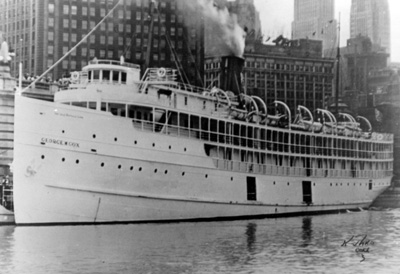
SS George M. Cox at Port: Kenneth E. Thro Collection, ISRO Archives.
George M. Cox was a millionaire ship builder and brewer from New Orleans, and a large stockholder of the Duke Transportation Company. The new owner had refitted PURITAN in a grand manner.
"I never had to shine shoes, but if I did I would try to do it better than the other fellow, and I am going to follow this same procedure with these boats," he said after the refitting and renaming of his company's newest boat was complete. "The boats are elegantly equipped and everything that can possibly be done will be offered for the passenger's pleasure. The ships, however, are going to remain clean - there'll be no gambling or disorder - if we have to sink them first. Our purpose is to supply two ships, and perhaps more, where every facility will be offered for clean and wholesome amusement and plenty of good times" (Manistee News Advocate May 25, 1933). -- George M. Cox
There was much excitement regarding the newly appointed GEORGE M. COX. On May 23, the ship, decorated with a new coat of white paint and carrying the International Code of Signals, left the moorings at Arthur Street in Manistee to move down to the Michigan Transit docks. Hundreds of people visited the ship as it lay at the dock, the crew finishing last-minute preparations for departure on COX's first voyage in more than two years. The ship was slated to leave for Chicago the next morning with George Johnson as captain and Arthur Cronk (appears as Kronk in most other references) of Houghton or Hancock, Michigan, as first mate. The refurbished vessel met with approval from its many visitors and well-wishers. "Entirely repainted, inside and out, the fine appearance of the ship won the favorable comment of those who inspected it" (Manistee News Advocate May 24, 1933).
Wreck Event
A description of the wreck given by the 23-year-old ship's staff nurse, Adeline Keeling, who was taken to Port Arthur with Cox, the injured passengers and crew (New York Times May 29, 1933):
"There was a heavy thud, followed by a series of crashes," said Miss Keeling. "The passengers were at dinner at the time. I saw a heavy buffet slide across the floor and crash into tables and a partition. I was in my stateroom and was thrown against a door and stunned. The stewardess, Beatrice Cote, helped me to my feet, and was herself knocked down in the second crash. She injured her back.
"There was no panic, but the steamer listed heavily to port and the passengers and crew rushed to starboard. It was impossible to lower the starboard boats because of the list of the vessel, but the port boats were lowered and ferried us all to the lighthouse."
The first voyage of PURITAN as the newly appointed GEORGE M. COX was also to be its last. On May 25, 1933 the ship left Chicago bound for Port Arthur to begin its new route in the passenger trade between those two cities. Intermediate stops were planned for Houghton and Isle Royale.
The steamer left Saturday May 27, from Marquette at 2:00 a.m. bound for Houghton with namesake George M. Cox and 124 others aboard (Daily Mining Gazette May 27, 1933). The captain was George Johnson of Traverse City and the first mate was Arthur Cronk. There was also an eight-piece orchestra aboard ready to join in the festivities anticipated on the maiden voyage (Manistee News Advocate May 24, 1933).
COX arrived in Houghton and tied up at the Peninsula dock around noon after its ten hour run. The vessel was opened for inspection and hundreds of local residents toured the finely appointed cruise ship (Daily Mining Gazette May 28, 1933).

SS George M. Cox, Rock of Ages Reef, 1933: R.E. Johns Collection, ISRO Archives.
Oral History 44: Harold J. Wescoat, February 07, 1983, Kenneth Vrana: ISRO Archives.
GEORGE M. COX left Saturday afternoon, May 27, 1933, for Isle Royale, but COX ran hard aground off the west end of Isle Royale sometime before 6:00 p.m. Saturday evening while those on board ate dinner. The steamer MORRIS S. TREMAINE intercepted a wireless SOS message from the stricken ship, and the first word reached Houghton about 8:00 p.m. Word of the disaster was received by Capt. Fred Sollman of the Portage Canal Coast Guard via Ft. William. The Coast Guard left immediately for the wreck site (Daily Mining Gazette May 28, 1933).
Five life boats were lowered on the port side; the boats on the starboard side were not launched because of the extreme port list. The passengers were loaded into the ship's lifeboats and towed to Rock of Ages by lightkeeper John Soldenski's motor launch. The passengers took turns warming themselves in the limited quarters of the lighthouse, and they were served hot coffee by the wife of the lightkeeper (Cleveland News May 29, 1933).
The operational procedures of the U.S. Coast Guard at Portage Canal Station and aboard the cutter CRAWFORD offer some insight into the COX rescue operations. About 8:00 p.m. the Portage Station received the following telegram, from Port Arthur: "Steamer GEORGE M. COX aground on Rock of Ages. In bad shape. Want assistance." (Letter from F.C. Sollman, Officer in Charge, Portage Station to John Hanson, Bureau of Navigation and Steam boat Inspection June 7, 1933). Within 10 minutes a lifeboat and crew left the station. The Portage crew arrived at the wreck site at 2:15 a.m. the morning of the 28th. All passengers and crew had been removed from the wreck and were safe on Rock of Ages.
On the 28th the story of the wreck appeared in the newspapers. The New Orleans Times-Picayune carried a detailed report prominently mentioning the president of Isle Royale Transit Co., a resident of New Orleans:
Four persons were injured, one seriously, in the wreck, the first on the Great Lakes this season, but no lives were lost. The four, with George M. Cox of New Orleans ... and a nurse were brought to Fort Williams by the freighter M.S. TREMAINE and placed in a hospital ....
Mrs. Cox said Sunday afternoon that she talked with her husband Sunday morning at Port Arthur, Canada, by long distance telephone and that he suffered no ill effects from his harrowing experience.
The GEORGE M. COX, making her first trip of the season, was en route to Port Arthur, Ont., from Chicago to pick up 250 Canadian residents and take them to the Century of Progress Exposition at the latter city. Thirty-two of the persons aboard on the out bound trip were passengers ....
Plowing through a heavy fog, the steamer, with its passengers at dinner, struck an extended ledge of rock a short distance from Rock of Ages Lighthouse with such force that her engines and boilers were ripped loose. The impact threw the passengers to the salon floors and sent tables and chairs crashing against the walls.
Keepers of the Rock of Ages Light said they saw the spars of the steamer above the low-hanging fog and made frantic but futile efforts to attract the' vessel's attention with the siren. A few minutes after the vessel struck she had broken open and filled with water until her top decks were awash.
Only the, fact that the Lake was calm enabled the keepers of the light and the crew of the steamer to transfer everyone to small boats and rafts and avoid loss of life.
The Portage crew transported 43 persons from the lighthouse to Washington Island hotel dock on Isle Royale and returned to Rock of Ages. Captain Johnson requested the removal of baggage from the wreck, and 71 bags, suitcases and other baggage items were taken aboard the lifeboat and transported to the lighthouse, arriving there at 8:40. Twenty crew members were transported from the lighthouse to CRAWFORD with some of the baggage, then 12 more of the COX crew were transported to Washington Harbor.
CRAWFORD arrived on site at 5:35 a.m., May 28, and anchored in 3 fathoms of water. Five minutes later the officer of the North Superior Coast Guard was aboard to brief the officers of CRAWFORD. Captain Johnson was consulted on the disposition of the passengers and crew. Johnson responded that he wanted them taken to Houghton, Michigan. The COX crew and passengers were loaded aboard, and the cutter proceeded to Washington Harbor to pick up the people who had been transferred there. The Coast Guard lifeboat from Grand Marais had engine trouble and was towed to the Singer Dock in Washington Harbor by CRAWFORD. The ship encountered dense fog on the way to the dock, finally arriving at 8:55 a.m. In an hour, all remaining people were loaded and CRAWFORD was underway to Houghton. The total aboard was recorded in the CRAWFORD log as 113 (Log of the U.S. Coast Guard Patrol Boat CRAWFORD May 27, 28, 1933).
Image Gallery
Shipwreck Site Map
Scattered wreckage, twisted steel plating, and exposed machinery and prop. Buoy attached to boiler in 45 feet.
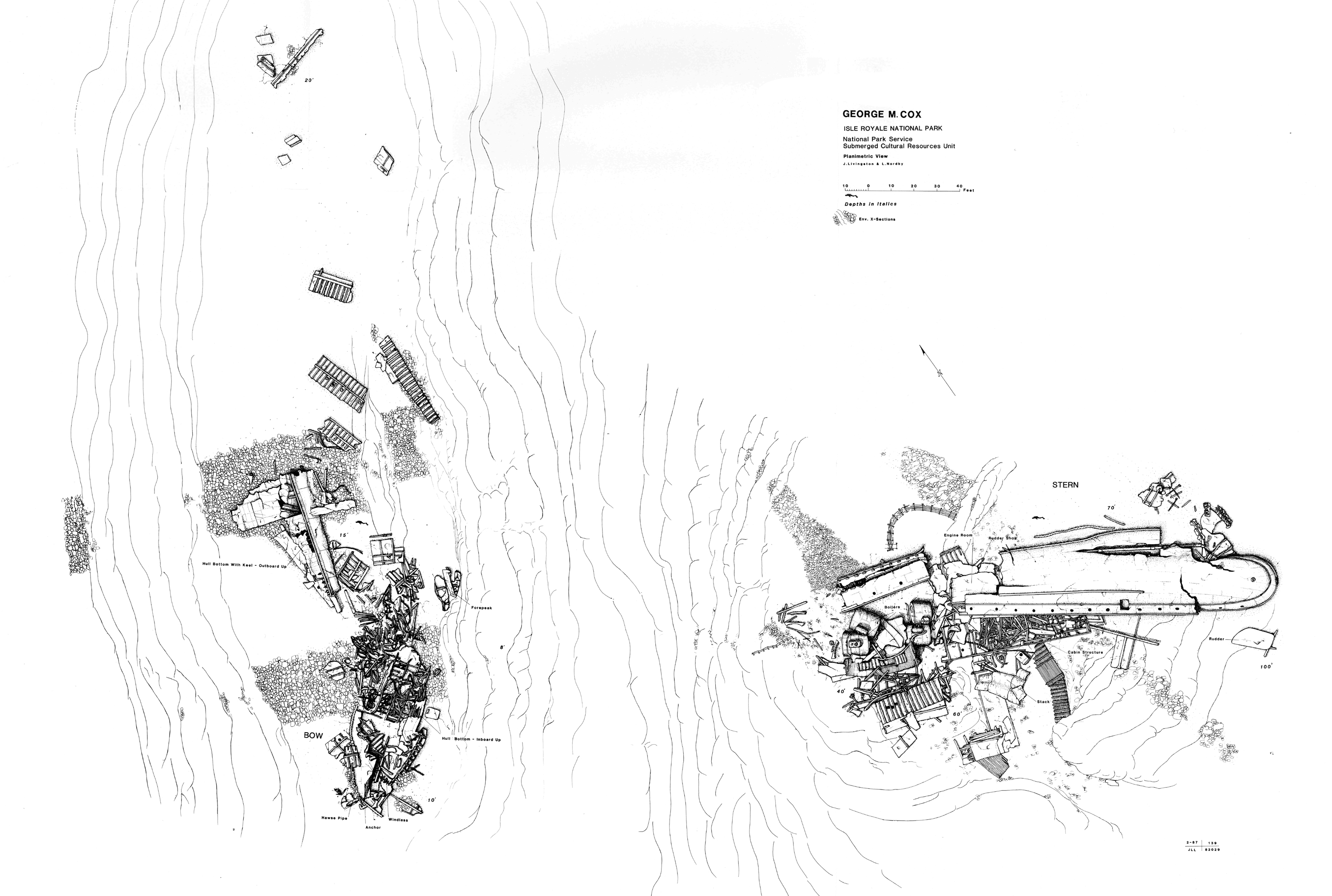
Hover
SS Cox Site Map, Submerged Cultural Resource Unit, J.L. Livingston & J. Nerdby, February 1987, ISRO Archives.
Citations:
- Isle Royale Shipwrecks. December 15, 1965. Isle Royale National Park Archives, Resource Management Records: Branch Chief Era, CRM History (ACC#ISRO-00614, Box 117), Houghton, MI.
- Lenihan, Daniel. Submerged Cultural Resources Study. Santa Fe, N.M: Submerged Cultural Resources Unit, National Park Service, 1987. Print.

